
Wingbox Aviation of the Philippines chooses OASES from Commsoft
Wingbox Aviation of the Philippines chooses OASES from Commsoft
Los Banos, Manila-based technical services organisation, Wingbox Aviation, has chosen Commsoft’s industry-leading MRO IT system, OASES, to support its diversifying fleet technical management operations.
Currently supporting over 130 aviation operations in more than 55 different countries, OASES is one of the most successful aviation engineering and maintenance systems in the world, combining a very high level of technical sophistication with an intuitive user interface. Designed by engineers for engineers, OASES is structured in a modular format to allow for scalability and Wingbox Aviation has contracted for the Core, Airworthiness, Planning, Materials and Line Maintenance Control modules.
Wingbox Aviation has also opted to access the modules through Commsoft’s private cloud service, avoiding the need to install any additional hardware.
Nick Godwin, Commsoft’s Managing Director, commented:
“The OASES user community is very much a global one and this latest win, the eighteenth OASES contract we have signed in 2017, represents a further step in our growing presence in Asia. We’re very much looking forward to working closely with Wingbox Aviation to help promote the software in conjunction with their extensive range of technical services to lessors, airlines and the business aviation communities.”
Darmilo Sosa, Managing Director of Wingbox Aviation, said
“This was a very exciting milestone to Wingbox Aviation. Our mission to provide the best solution to Philippines aviation and as well as the Asian market will make it solid. OASES by Commsoft is a tool that all fleet management technical people would dream to have. I am very happy to introduce the Fleet Technical Management Solution to Philippines small airlines, general aviation and corporate jet operators and I think with OASES as a tool we will gain ground for a more reliable and cost-effective services”
This latest contract win for Commsoft also highlights the breadth of the OASES user community, which includes national, regional and charter airlines, cargo specialists and leasing companies as well as CAMO and 3rd party MRO operations.
Where does Santa’s sleigh actually fly?
Where does Santa’s sleigh actually fly?
Lufthansa Systems delivers relevant flight data for calculating Santa Claus’ optimum route around the world
Raunheim, December 19, 2017 – To make sure the man with the white beard and red suit can deliver all his gifts on time again this year, a team of experts from Lufthansa Systems worked with representatives from the MATHEON Research Center and Konrad Zuse Institute Berlin to calculate the shortest round trip around the globe. The project was launched by the German “Wissenschaft im Dialog” research initiative at the end of 2016.
The team discovered that Santa Claus needs approximately 406 hours, or almost 17 days, to reach every single child in the world. In doing so, he would travel 365,174 kilometers, equivalent to more than nine times the circumference of the Earth. The optimal flight route takes him from the North Pole via Europe and the Middle East to Russia, and then on to Asia and back to Africa. After that, the sleigh travels on to North and South America, stopping off in Hawaii before heading for Papua New Guinea and Australia. Santa’s return journey includes one or two more stops in Asia, on the Arabian peninsula and in Europe before he can final enjoy a well-deserved rest back at the North Pole. As the route leads from west to east across the International Date Line, he even loses a day along the way. Nevertheless, Santa’s ability to stop time led the team to conclude that this will be no problem and that all children will once again wake up to a Christmas surprise or two again this year.
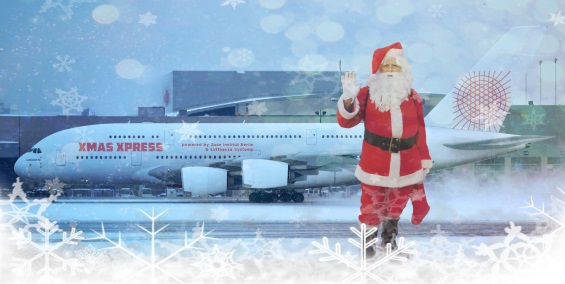
Flight planning solutions always calculate the shortest flight connection between two waypoints, while taking into account factors such as flight time, aircraft type, fuel consumption and weather. The calculation for this project was based on the following simplified assumptions: The route begins at the North Pole and includes 1,305 destinations around the world. To save time, Santa Claus does not land en route. Instead, he throws presents from his sleigh and lets his regional elves distribute them. He flies at a constant speed (900 km/h) and altitude (10 km). His ground speed (speed relative to the surface of the Earth) takes the wind into account. It increases with a tailwind and decreases with a headwind, and Santa also compensates for crosswinds. Santa has to stop time to complete the long journey, which means weather conditions also remain constant – the assumption uses the conditions at 23:00 UTC on Christmas Day 2015. As he carries a bottomless sack of presents, the weight of gifts for two billion children is not included in the calculation. Similarly, overflight fees are not taken into account in this case. Under these conditions, a connection with minimal fuel consumption (or reindeer food) also has the shortest flight time.
Crossovers, loops and apparent detours on the route are not mistakes. A longer flight route can be faster and save more fuel than what appears to be the best direct connection in a large arc. In addition, Santa Claus’ status as a role model for children everywhere means he must remain on the network of airways. This global network has around 300,000 routes at each of approximately 30 permitted altitudes.

Aviation IT specialist Lufthansa Systems contributed the relevant airways network data for this project together with additional weather and aircraft performance information. Flight planning experts are thoroughly familiar with these criteria, as around 120 airlines with a total of more than 6,000 aircraft worldwide use Lufthansa Systems’ Lido/Flight 4D flight planning solution, which has been successful in the market for just over 20 years and has a market share of 45 percent in Europe alone. If Santa Claus adds connectivity to his sleigh in future, it will even be possible to incorporate live weather data from Lido/Navigation into the calculation.
Anyone wanting to follow Santa’s route can download the appropriate KML file at www.wissenschaft-im-dialog.de. Direct link: https://tinyurl.com/yatfma89
Google Earth must be installed in order to view the file.
Images (Copyright: Google Earth): Excerpts of Santa’s optimal route, according to calculations from Lufthansa Systems, MATHEON and the Konrad Zuse Institute.
For more information about the project partners, visit: www.zib.de and www.matheon.de
Transavia France signs an agreement with Paris based start-up Safety Line to reduce its 2018 carbon footprint by 6500 tonnes!
Transavia France signs an agreement with Paris based start-up Safety Line to reduce its 2018 carbon footprint by 6500 tonnes!
Transavia, the low-cost airline of the Air France-KLM Group, and Paris based start-up Safety Line signed an agreement Monday December 18th 2017. Starting from 2018, all Transavia pilots will implement Opticlimb, an Artificial Intelligence solution combining historical flight data and real-time flight conditions to compute optimal climb profiles allowing to reduce fuel consumption. OptiClimb therefore allows to both reduce fuel costs and limit carbon emissions. On the basis of 5 to 10% savings of climb fuel, the airline hopes to achieve fuel savings of more than 2000 metric tons by 2019.
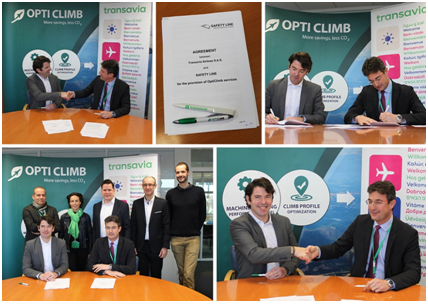
A target of 2000 metric tons less fuel consumed in 2018, for 6500 metric tons less CO2 emissions The climb phase consumes the most fuel. This is what led Safety Line to come up with « OptiClimb ». Thanks to OptiClimb, Transavia looks forward to optimizing climb profiles in order to reduce its fuel consumption and thereby its carbon footprint. Transavia France CEO Nathalie Stubler, stated : « The signature of this partnership is the fruit of joint efforts over a number of months between the Safety Line team and the Transavia teams. Deploying OptiClimb on all of our flights will allow us to reduce CO2 emissions and fuel consumption for a key portion of the flight, the climb phase. This partnership is an additional step in our endeavours to work with companies who offer innovative solutions, with a view to further improve Transavia’s performance. »
Based on test results over the last two years, OptiClimb allows to save between 70 to 80 kg of fuel for each climb. This means over 2000 metric tons of fuel will be saved by 2019.
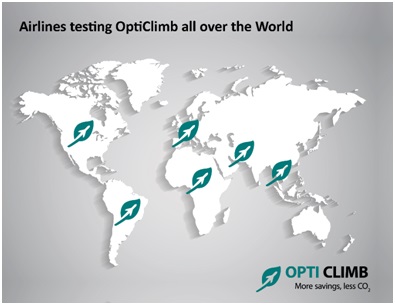
2 years of tests
Leading up to the signature of this agreement, Transavia and Safety Line have worked together for the last 2 years, test campaign after test campaign. This project, led by Transavia France, has involved joint work by Transavia’s french and dutch teams. This cooperation has allowed the development of an innovative solution with solid potential – Transavia and Safety Line have the joint ambition of extending fuel savings to the cruise phase in the medium to long term.
Start-ups at the heart of Transavia’s strategy
Since its creation, Transavia France has been striving to implement innovative solutions to improve its
performance.
Transavia structures its outreach to start-ups around three main development priorities:
– Innovations in the quality of service to passengers;
– Optimisation of the airline’s operational performance;
– Improvement of the airline’s environmental footprint.
Transavia was the first airline to partner up with Safety Line, who is now testing OptiClimb with 22 other airlines. Safety Line’s founder and CEO, Pierre Jouniaux, stated: « We are proud to announce Transavia as first customer for OptiClimb. Thanks to a close cooperation with Transavia’s management and pilots and over 2000 flight test, we were able to validate the results of several years of research jointly led with INRIA/Polytechnique, France’s lead research lab for Data Sciences. If all commercial aircraft carrying 100 passengers and above were to implement OptiClimb, yearly CO2 emissions could be reduced by 4,5 million metric tons, or the equivalent of the carbon footprint of the city of Paris. Thanks to this partnership with Transavia, who are always eager to innovate, we look forward to exploring further opportunities to save fuel on other flight phases ».
Jet East Corporate Aviation, LLC. TRUSTS Ramco
Jet East Corporate Aviation, LLC. TRUSTS Ramco
Leading US-based AOG maintenance provider will implement complete Aviation Suite including Finance & HR from Ramco to modernize its business systems
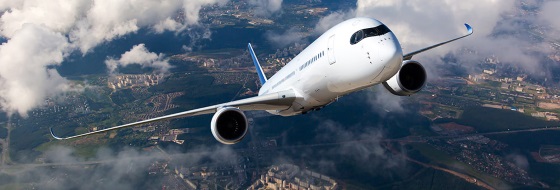
New Jersey, USA / Chennai, INDIA – December 18, 2017 – Ramco Systems, the global aviation software provider on Cloud and Mobile, today announced that it has won an order from Jet East Corporate Aviation, LLC., to implement Ramco Aviation Suite V5.8. In addition to the Aviation modules, Jet East will also implement Ramco’s complete Finance, HR & Payroll offering to get an integrated view of its business operations.
Jet East was looking for a solution to move its paper based manual operations to a completely automated, mobile-ready platform which can capture all processes in real time. Built from the ground up for the aviation industry, Ramco Aviation Suite fit the needs perfectly by offering an integrated suite that will bring Jet East’s Engineering & CAMO, Maintenance, Materials Management, Quality & Safety, and MRO Sales, including HCM, Payroll and Finance under a single platform. Bundled with innovative features like Mobility and HUBs, Ramco’s offering aims at automating manual processes, thereby increasing productivity and optimizing aircraft turn-around time (TAT).
“We are taking a digital leap ahead with Ramco to address both our current and future needs”, said, Francis D John, CEO, Jet East Corporate Aviation, LLC. “Ramco offers us a one-stop solution that can address the end-to-end needs of our organization. We are excited to be working with Ramco, which we are confident will allow Jet East to better serve our customers and more effectively manage our rapidly growing aircraft maintenance business.”
Commenting on the latest win, Virender Aggarwal, CEO, Ramco Systems, said “The addition of Jet East to our clientele reflects the strong footprint we have in Aviation MRO. The ability to address Aviation specific business needs and also offer all ERP modules in a comprehensive package is helping us win hands down against competition. Bundled with next-gen, intuitive features like Chatbots and Mobility, Ramco Aviation Suite has been helping organizations embrace digitalization.”
Ramco Aviation Software is trusted by 21000+ users to manage 4000+ aircraft, globally. Designed to be accessible on cloud and mobile, Ramco Aviation Software continues to add technological innovations with ‘Anywhere Apps’, redefining the power of Mobility, to significantly reduce transaction time both during AOG conditions and critical aircraft turnarounds. Ramco is changing the paradigm of enterprise software with ZERO UI powered by cool new features such as Chatbots, Mail bots, HUBs and Cognitive solutions. Furthering this, the company has also developed application compatibility on Microsoft HoloLens to bring Augmented Reality which improves efficiency in maintenance operations. With 75+ Aviation leaders onboard, Ramco is the solution of choice for several large airlines and top heli-operators and multiple MROs in the world.
10 years of Mobile ONAIR – celebrating a decade of inflight innovation
10 years of Mobile ONAIR – celebrating a decade of inflight innovation
Monday 18 December 2017 – SITAONAIR is celebrating a decade since the first ever inflight cellular data transmission and the birth of Mobile ONAIR.
Since that initial transmission was made onboard an Airbus A318 flight on 17 December 2007, it has been installed in more than 550 aircraft, serving the changing needs of commercial, VIP and governmental flights alike.
Over the past decade, and with support from SITAONAIR’s industry partners, the service has been made available across all aircraft types, from single-aisle to long-range – with more than 20 million passengers connecting for voice, SMS and data transmission in 2017 alone.
Reflecting on that first flight, Veronique Blanc, CTO at SITAONAIR (then OnAir) in 2007, says: “The launch of Mobile ONAIR and the first cellular data transmission was very exciting for everyone involved. Back then, even before the widespread use of smartphones, we knew that what we were doing was hugely innovative, and paving the way for the future of inflight connectivity.”
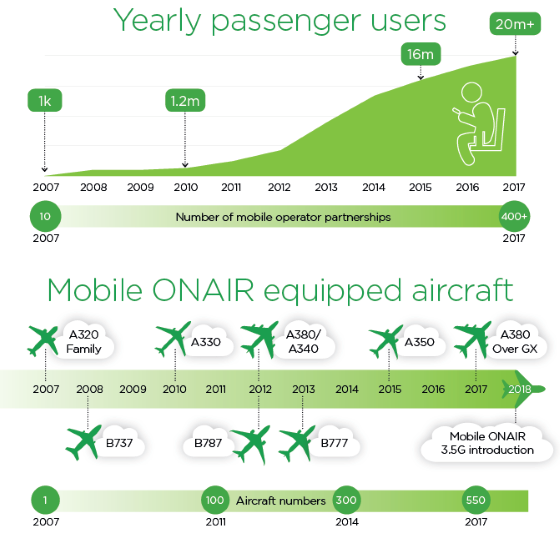
SITAONAIR and satellite communications provider Inmarsat worked in partnership on that milestone flight ten years ago, and since these exciting early days, the service has continued to evolve, with developments such as the recent deployment of cutting-edge inflight 3.5G mobile network services over the high-speed broadband satellite connectivity of Inmarsat’s GX Aviation. This aviation industry first sees passengers and crew benefit from high-speed and seamless connectivity, which is comparable to the home experience.
Mobile ONAIR also enables passengers to utilize simple, secure and reliable connections that contribute to 43% of frequent fliers citing cellular connectivity as their primary choice. This is complemented by the continued evolution of pricing models, from the comparatively expensive price-per-use model that dominated until 2013, to the unlimited mobile data bundles commonly seen today, and the ‘Roam Like at Home’ model, which is set to become the norm across Europe.
Thanks to SITAONAIR’s work in obtaining regulatory approval and securing mobile operator partnerships, the Mobile ONAIR service is truly global. It is easy to forget a time, not so long ago, when passengers turned off mobile phones onboard an aircraft. SITAONAIR, together with partners and customers, has helped secure the regulatory approval, at state and industry level, to make the dream of inflight mobile connectivity a reality for the whole industry.
Passenger experience
SITAONAIR’s latest infographic highlights how cellular data is a crucial ingredient for a first class passenger experience, cementing Mobile ONAIR’s relevance in the connected airspace.
Gregory Ouillon, Chief Technology Officer at SITAONAIR, says: “It’s remarkable to think that it was just ten years ago that SITAONAIR launched the world’s first inflight mobile service onboard an international flight.
“Ten years is a long time in aviation, however, and the solution now has evolved to become an essential component of the full cabin connectivity experience, allowing passengers to use their mobile phones as they would on the ground.
“One major shift has been the trend towards the convergence of Wi-Fi and cellular technologies, which delivers the best of both worlds. Passenger expectations can be met by offering a hybrid experience that can leverage the advantages of both a Wi-Fi and a cellular connection. Importantly, SITAONAIR is one of the few industry players with the knowledge, assets and skills base to make this convergence happen.”
This convergence is essential to meet the demands of the modern passenger. With 50-100 billion Internet connected devices expected to be in circulation by 2020, ranging from fitness trackers to thermostats, mobile network operators will play a central role in connecting these devices, both on the ground and in the air.
Moving towards the future
From supporting this burgeoning IoT movement, to the introduction of wider cellular trends like ‘Roam Like at Home’ to the air, our new infographic examines the future of Mobile ONAIR and inflight passenger communication, as SITAONAIR and its partners see it.
Frederik van Essen, Inmarsat Aviation Senior Vice President says: “Passenger expectations around inflight connectivity have dramatically evolved over the past decade. Inmarsat worked shoulder-to-shoulder with SITAONAIR ten years ago to pioneer the first ever inflight mobile phone call and data connectivity on an international flight.
“Today, we are together introducing unprecedented new capacities with GX Aviation, ensuring that airline passengers can browse the internet, stream videos, check social media and more during flights, with an onboard connectivity experience comparable to the mobile broadband services they may receive on the ground.”
For more information and to discover the full SITAONAIR connected aircraft portfolio, visit www.sitaonair.aero
To download the infographic for publication in full, click here (Credit SITAONAIR).
Tsunami Tsolutions joins IFS Partner Network for Aviation & Defence sector
Tsunami Tsolutions joins IFS Partner Network for Aviation & Defence sector
Leading military and aerospace solutions provider will market and support IFS Applications™ and IFS Maintenix™ to drive growth in global Aviation & Defence industry
December 13, 2017 – IFS, the global enterprise applications company, today announced that Tsunami Tsolutions LLC, a leading Aerospace & Defence solutions provider based in North America, has joined the IFS Partner Network. The strategic partnership will increase delivery capacity of IFS Applications™ and IFS Maintenix™ to the global Aviation & Defence (A&D) industry and help customers streamline complex, asset-intensive operations.
Tsunami provides information technology and engineering solutions to leading organisations in the aerospace, military, and Maintenance, Repair & Overhaul (MRO) industries, including Pratt & Whitney, Lockheed Martin, and United Technologies. Its solutions and target markets fit well with IFS which has proven Enterprise Asset Management (EAM), Enterprise Resource Planning (ERP) and MRO solutions, and a strong market presence within Aviation & Defence. IFS was recently named the leading vendor of EAM to the A&D sector in terms of market share by business analysts ARC Advisory Group.
The Tsunami product portfolio addresses key A&D processes from logistics & inventory management, spare/repair parts management and maintenance tracking, to cost forecasting and aftermarket sales support. This expertise, when combined with the industry-leading knowledge of IFS, will enable Tsunami A&D customers to streamline asset-intensive operations to keep pace with the evolving defence environment and dynamic commercial aviation sector.
“Tsunami’s success is built on establishing strong relationships with our customers and growing our portfolio by working closely with key business partners. We are looking forward to working with IFS to expand our offerings and best support our customers in the rapidly changing aviation and defence markets,” said Matt Atwater, founder and CEO of Tsunami Tsolutions.
“The partnership with Tsunami is reflective of the global success IFS is currently experiencing in aviation and defence,” said Scott Helmer, Senior Vice President at the Aviation & Defence Business Unit, IFS. “Strategic partners like Tsunami play an essential role in delivering and building on the capabilities of IFS, while helping us expand into new markets and regions. We are thrilled to continue working closely with Tsunami and sharing our mutual expertise to further support our growing A&D customer base.”
For more information about the IFS Partner Network, please visit http://www.ifsworld.com/uk/partners/
For more information on how IFS supports companies in aviation and defence, visit http://www.ifsworld.com/uk/industries/aviation-and-defence/
Enlightened Lighting: UTC Aerospace Systems Unveils Longer-Lasting, More Reliable A320 Wing Navigation Lights
Enlightened Lighting: UTC Aerospace Systems Unveils Longer-Lasting, More Reliable A320 Wing Navigation Lights
– New lights offer longer-lasting LED technology, increased resistance to humidity, and are interchangeable with current A320 units
– System has received Supplemental Type Certificate from FAA and EASA
 CHARLOTTE, N.C., Dec. 13, 2017 /PRNewswire/ — UTC Aerospace Systems, a division of United Technologies Corp. (NYSE: UTX), announced today that it has recently received a Supplemental Type Certificate (STC) from both the U.S. Federal Aviation Administration (FAA) and the European Aviation Safety Agency (EASA) for a set of new, advanced technology LED wing navigation lights for the Airbus A320 aircraft family. Through a combination of innovative features, the lights are designed to offer customers a convenient retrofit option that provides enhanced longevity and reliability to reduce maintenance and operating costs.
CHARLOTTE, N.C., Dec. 13, 2017 /PRNewswire/ — UTC Aerospace Systems, a division of United Technologies Corp. (NYSE: UTX), announced today that it has recently received a Supplemental Type Certificate (STC) from both the U.S. Federal Aviation Administration (FAA) and the European Aviation Safety Agency (EASA) for a set of new, advanced technology LED wing navigation lights for the Airbus A320 aircraft family. Through a combination of innovative features, the lights are designed to offer customers a convenient retrofit option that provides enhanced longevity and reliability to reduce maintenance and operating costs.
Equipped with longer-lasting LED technology, the new lights boast a mean time between failure (MTBF) of 39,000 operating hours. Each light contains two redundant high-power LED systems, for enhanced reliability. A near-end-of-life indicator provides the user with a visual indication when 1,000 operating hours remain. In addition, the lights are engineered to provide increased resistance to humidity through a proprietary production process.
Currently in service with major European and North American airlines, the new lights are mechanically and electronically interchangeable with current units installed on A320 conventional wing tips.
“At UTC Aerospace Systems, we’re committed to continuously developing technologies and creating products that save our customers time and money, and that’s precisely what our new wing navigation lights are designed to do,” said Mike Wagner, Senior Director of Aftermarket for Interiors. “With the recent certifications from FAA and EASA, airlines can now retrofit their A320 fleets with these new lights, and benefit from the increased reliability and operational efficiency they provide.”
Based in Lippstadt, Germany, Goodrich Lighting Systems GmbH designs and manufacturers tip-to-tail interior and exterior lighting products for commercial aircraft, regional and business jets, military aircraft and rotorcraft. With decades of experience in developing and producing aircraft lighting, the business combines the latest technology with sophisticated designs and elaborate optical concepts to help its customers reduce maintenance and operating costs.
Congo Airways opts for solutions from Lufthansa Systems
Congo Airways opts for solutions from Lufthansa Systems
Several Lido/Navigation solutions being used successfully
Raunheim, December 12, 2017 – Lufthansa Systems today announced that Congo Airways is using several of its products, specifically the paper-based Lido/eRouteManual maps, the paperless Lido/mPilot navigation solution, Lido/FMS data for flight management systems and the Lido/FPLS flight planning service.
Congo Airways was established in 2014, with flight operations commencing in 2015. “We were looking for products that would deliver added value from day one. We were quickly impressed by the solutions from Lufthansa Systems. Thanks to their high quality and short delivery times, we were able to meet our internal schedule and successfully and swiftly establish us in the market,” said Désiré Balazire Bantu, Chief Executive Officer & Accountable Manager at Congo Airways.
Congo Airways is benefiting from several solutions: The paper-based Lido/RouteManual maps and the mobile Lido/mPilot solution help pilots with the processes involved in flight preparation and operation. The maps feature true-to-scale topographical information and meet the highest standards of precision and quality. Layout, colors and symbols are identical in the maps’ paper and electronic versions. These maps are generated directly from the Lido/FMS navigation database. The FMS database contains all important route information such as altitude data, airways and airport data for optimizing navigation and supporting autopilots on board modern aircraft.
The navigation data, which is based on global aeronautical information, are updated every 28 days according to the AIRAC cycle. The Lido/FPLS flight planning service automatically calculates reliable routes for flight operations, taking into account factors such as cost, flight time and fuel consumption.
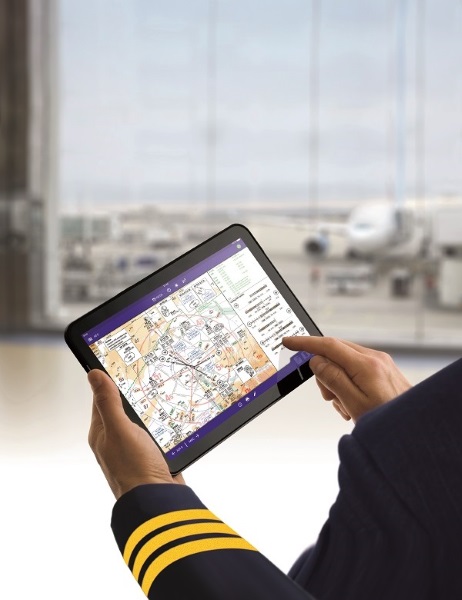
“We are pleased to be able to support Congo Airways in growing its business. This example shows that not only large but also smaller airlines benefit from Lufthansa Systems’ solutions. This is true even if they are forced to map or build flight operations under difficult circumstances while emphasizing high levels of quality and safety,” said Marco Cesa, Senior Vice President Regional Management EMEA at Lufthansa Systems.
Congo Airways commenced flight operations in 2015. The company is based at N’djili Airport, Kinshasa, and has a fleet of five aircraft; two more have been ordered. While the carrier has mainly served cities within the Democratic Republic of the Congo up to now, this year’s schedule also includes international destinations in Africa.
Caption (Copyright: Lufthansa Systems): The digital navigation solutions from Lufthansa Systems support pilots before, during and after a flight.
Two-thirds of airlines to enter new era of connected onboard services by 2020
Two-thirds of airlines to enter new era of connected onboard services by 2020
Analysis of parent company SITA’s 2017 Air Transport IT Trends Insights research uncovers airlines’ connected aircraft priorities for next three years
Tuesday 12 December 2017 – More than 90% of airlines are set to ramp up investment in advancing wireless services for cabin crew and pilots over the three years to 2020 – an 18% increase since SITA’s 2016 Airline IT Trends survey. This is according to award-winning connected aircraft services expert SITAONAIR, as it presents SITA’s 2017 Air Transport IT Trends Insights into the connected aircraft.
Over a third (34%) of airlines expect to receive connected aircraft deliveries within the next three years, compared with more than a fifth (21%) in SITA’s 2016 Airline IT Trends Survey. SITA’s 2017 Insights also found 69% of carriers committing to a major program (40%) or R&D/trial (29%) to establish full satellite broadband connectivity to aircraft.
Enhancing the passenger experience is far and away the connected aircraft’s biggest encountered and perceived benefit, according to 43% of airlines. A combined 31% meanwhile, cited operational benefits across maintenance and aircraft health monitoring, cockpit and cabin, as the chief advantages of a connected aircraft. In testament to this, 78% of surveyed carriers reported automatic aircraft data management as an investment priority – 33% through major programs, 45% in R&D programs – by 2020.
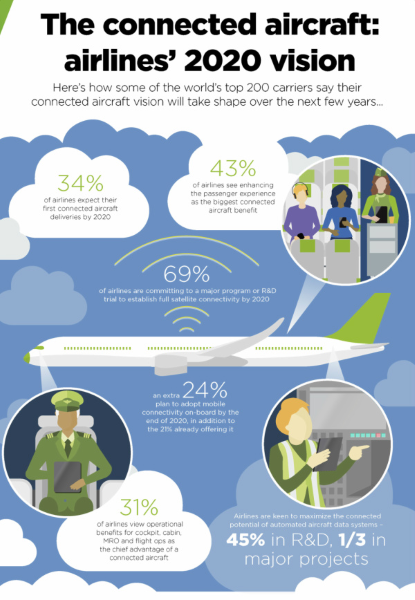
Wi-Fi advancement focus for forward-looking carriers
When asked for their investment focuses up to 2020, 94% of airlines surveyed as part of SITA’s 2017 Air Transport IT Trends Insights study cited wireless services for cabin crew or pilots (64% in major programs; 30% in R&D or trials). This was closely followed by 91% of carriers targeting investment in wireless inflight services for passengers (54% in major programs; 37% in R&D or trials).
SITA’s connected aircraft Insights data also reveals airline ambitions to boost Wi-Fi data bandwidth in the years to come, with 60% of airlines surveyed planning to, or having already implemented, high-speed Wi-Fi by 2020.
Airline inflight connected services shopping list
Assessing airlines’ most-coveted inflight entertainment and connectivity (IFEC) services, the insights found that providing a destination services app was the technological advancement that carriers are most enthusiastic to establish by 2020 (72% – up from 46% in 2016). This was closely followed by a Duty Free shopping app (61%, a rise from 48% last year).
Passengers’ preference for enjoying inflight entertainment (IFE) via BYOD – e.g. with a ‘second screen’ of their own – was reinforced for a second consecutive year, with 24% having invested in Wireless IFE to passengers’-own devices and 46% planning to do so by the end of 2020. Providing infotainment to personal devices or apps – namely, news, magazines and books – and inflight communication services, proved similarly high in the airline IFEC shopping list, at an additional 47% and 43% each against the airlines that have already implemented.
On the hot topic of pricing for delivering onboard Wi-Fi passenger services, roughly the same proportion of ‘tails’ expressed ambitions to provide free (an additional 43%) and paid-for Wi-Fi sessions (an additional 42%) by 2020 – with many airlines already exploring business models.
“More mobile” experience
A significant proportion of operators revealed a desire to invest further in mobile technologies for passengers and crew, reflecting the “always available” trend on the ground, and with potentially transformational benefits for crew and passenger engagement and service on-board.
A stark 87% of surveyed carriers in 2017 (compared to 75% in 2016) have implemented or plan to implement mobile services to enhance customer relationship management in the next three years. 75% of surveyed carriers expressed ambitions to invest in major programs around apps for passenger mobile services. Around half (47%) of carriers are focusing investment on major programs for social media-hosted passenger services; and a total 44% plan on major programs or R&D/pilot programs for wearable technologies for staff.
Connected future
Reflecting on the findings, SITAONAIR’s Vice President of Strategy, Dominique El Bez, said: “Our industry’s connected aircraft vision, with its complete, connected inflight experience, is irrefutably here to stay. Airlines are increasingly aware of the value-added benefits presented by in-flight connectivity options that we at SITAONAIR are experts in delivering, to advance their RoI.

“On the cabin connectivity side, these benefits span everything from enhancing airlines’ brand perception in the eyes of passengers, by enabling them to stay connected to their digital lives when they fly via Wi-Fi or cellular, to digitizing cabin crews to personalize the passenger experience with intelligent, CRM-integrated applications. From supporting airlines to monetize inflight connectivity services with clever onboard sponsorship partnerships; or supporting passengers’ choice to enjoy wireless inflight entertainment; to empowering passenger autonomy through delivering connected mobile applications and services to keep them informed and entertained on the move.
“For the cockpit, airline flight operations, management, and safety, connected solutions bring a significant lift to efficiencies and safety procedures. How? From deploying digital solutions that deliver the latest flight context information into the hands of pilots; ever-evolving our flight tracking and flight planning solutions to ensure airlines meet ICAO recommendations to frequently report fleet positions; to providing secure multilink communications to support every stage of flight.
“We also see accelerating industry interest in managing and harnessing the power of aircraft data. Such innovation advances flight and MRO operations with predictive and enriched aircraft operations. Amongst the emerging technologies reported by airlines, 67% plan to invest into initiatives around the Internet-of-Things, 52% around Artificial Intelligence and 44% on wearable technology for staff. All present amazing potential for enhancing airlines’ operations inflight and on the ground.”
Mr El Bez continued: “We at SITAONAIR want to see more airlines able to achieve their connected aircraft aims, however. We truly believe the air transport industry needs to work harder to empower the world’s airlines to get connected, by embracing our open platforms approach to inflight connectivity innovation. Our pioneering ‘open cabin’ attitude is already creating harmony across airline fleets and avionics, and data-rich customer relationship management systems, helping deliver airlines’ unique passenger experiences without expensively overhauling their fleets.”
See our shareable infographic, The connected aircraft: airlines’ 2020 vision, in full, capturing SITA’s connected aircraft Insights data.
Discover SITAONAIR’s complete nose-to-tail connected aircraft portfolio – enhancing passenger experience, operational efficiencies, and unlocking inflight connectivity’s true value – by exploring www.sitaonair.aero, or enquiring here.
You can read the full SITA Air Transport IT Trends Insights 2017 report for more findings on IT spend, investment priorities, cyber security, self-service. mobile and emerging technologies.
ENGINEERING Holding selects AMOS
ENGINEERING Holding selects AMOS
At a glance
- AMOS to be implemented at four aviation organisations
- Implementation of new AMOS MRO Edition
AMOS footprint in Russia unrivalled
Swiss AviationSoftware Ltd. proudly announces signed contracts with ENGINEERING Holding. AMOS will contribute to the work scope expansion as well as digitalisation strategy of four organisations: ENGINEERING Holding, S7 Engineering, Sibir Technics and Cyprus Airways.
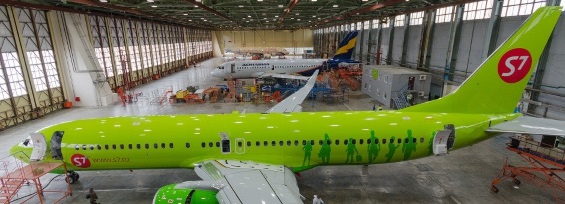
Creating synergies with AMOS
Thanks to the AMOS Financial Multi Entity functions, the MRO organisations of the group will work within the same AMOS environment and benefit from synergies due to common processes and integrated transactions between the entities. Cyprus Airways will have its own AMOS environment under the group umbrella agreement as processes and business needs of this airline differ from those of the MRO providers.
AMOS MRO Edition
“We are delighted that our new AMOS MRO Edition convinced another high profile aviation group. It is the acknowledgment that the newly released MRO modules are well received in the market,” states Ronald Schaeuffele, CEO of Swiss-AS.
The AMOS MRO Edition was issued with AMOS Release 12 on 1st November 2017. The new business functions that have been added to AMOS, like Facility/Hangar Planning, Ground-time Management, Finance Control Dashboards, CRM and in-depth Quotation/Contract Management will assist the aviation group to serve its large customer base. Many of the group clients are already AMOS customers this, of course, generated additional arguments in favour of AMOS during the pre-sales process.
